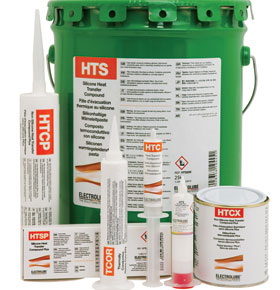

During use, some electronic components can generate significant amounts of heat. Failure to effectively dissipate this heat away from the component and the device can lead to reliability concerns and reduce operational lifetimes.
Newton’s law of cooling states that the rate of loss of heat is proportional to the temperature difference between the body and its surroundings. Therefore, as the temperature of the component increases and reaches its equilibrium temperature, the rate of heat loss per second will equate to the heat produced per second within the component. This temperature may be high enough to significantly shorten the life of the component or even cause the device to fail. It is in such cases that thermal management measures need to be taken.
The same considerations can be applied to a complete circuit or device which incorporates heat producing individual components. Heat is lost from a component to its surroundings at the surface of the component. The rate of loss of heat will increase with the surface area of the component; a small device producing 10 Watts will reach a higher temperature than a similar powered device with a larger surface area.
This is where heatsinks are used – varying in size and shape, they can be designed to offer a significantly increased surface area to maximise heat dissipation. They are typically connected to components which generate a large amount of thermal energy when in operation and therefore dissipate such energy away from the device to avoid failure due to overheating.
Heat sinks have proven to be highly effective over the years, however in order to ensure full contact and therefore maximum efficiency, thermal management products are used in conjunction.
Metal surfaces, even when polished to a fine degree, have a certain amount of roughness. It can therefore be deduced that when two metal surfaces are placed together contact is not 100% and there will always be an air gap between the two surfaces. The use of a thermal interface material between such gaps ensures complete contact between the two surfaces and in turn more efficient heat conductance.
The ongoing trend for product miniaturisation – coupled with more modern, higher-powered devices – has ensured that efficient thermal management is an essential part of both modern and future electronics design, the LED lighting market being just one example.
Electrolube’s thermal management products also provide solutions for greater efficiency in green energy development; photovoltaic inverters – which are known to be particularly sensitive to temperature; connections between the heat-pipe and water storage tank for solar heating applications; hydrogen fuel cells; wind power generators; and many more applications besides.
| Tel: | +27 11 454 8053 |
| Email: | [email protected] |
| www: | www.vepac.co.za |
| Articles: | More information and articles about Vepac Electronics |

© Technews Publishing (Pty) Ltd | All Rights Reserved